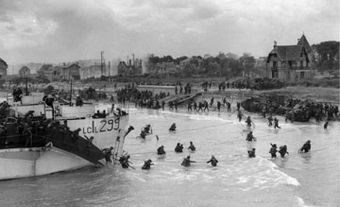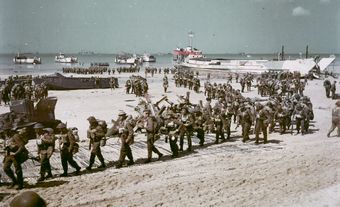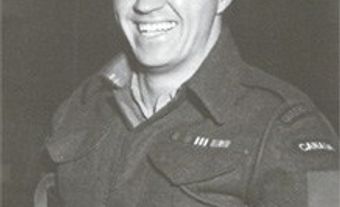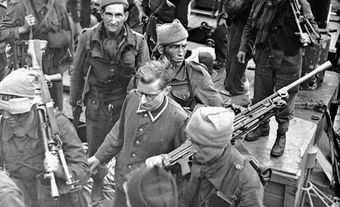The Juno Beach Centre (JBC) is a Canadian museum located in Courseulles-sur-Mer, France. It is situated behind Juno Beach, the Allied code name for a 10 km stretch of French coastline assaulted by Canadian forces on D-Day, 6 June 1944, during the Second World War. Opened by a group of veterans and volunteers in 2003, the Juno Beach Centre is a memorial and education centre dedicated to commemorating the role of Canadians in the Second World War. It is privately owned and operated by the Canadian non-profit Juno Beach Centre Association (JBCA), which offers historical and educational programming across Canada.

History and Mission
In the mid-1990s, a group of Second World War veterans travelled to Europe to share with their families the routes they had marched after landing on Juno Beach in the early morning hours of D-Day, 6 June 1944 (see D-Day and the Battle of Normandy). They encountered many comprehensive national museums and memorials at the American and British landing beaches, but no such equivalent to recognize Canadians.
Upon returning home, the veterans, their families and volunteers began a fundraising effort to support the construction of a Canadian museum and education centre to commemorate the sacrifices made by Canada and educate future generations about the Canadian role in the Second World War. Led by Lieutenant Garth Webb, a D-Day veteran of the 14th Field Regiment, Royal Canadian Artillery, they sought support from Canadian individuals and companies, as well as various levels of government. After years of fundraising, ground was broken for the Juno Beach Centre on a 1.5-hectare site provided by the town of Courseulles-sur-Mer in France. Garth Webb, supported by his partner Lise Cooper, opened the Juno Beach Centre on 6 June 2003 (see D-Day Vet’s Memorial Centre Opens).
After nearly 20 years of fundraising, Garth Webb passed away on 8 May 2012. The core purposes of the Juno Beach Centre (JBC) and the Juno Beach Centre Association (JBCA) remain true to Webb’s original vision to:
“Provide a tangible and fitting memorial to Canada’s participation in the Second World War and recognize the emergence of Canada on the world scene;
“Remember and commemorate the sacrifices made by all Canadians who were part of the Allied victory in all theatres of war and at home; and
“Educate adults and children of today and future generations about the role of Canada in preserving the freedoms we are privileged to enjoy today.”
Since 2003, the JBC has hosted Canadian commemorative ceremonies marking milestone D-Day anniversaries. These events have been attended by French and Canadian leaders and British royalty. Prime Minister Justin Trudeau visited the JBC with members of his family in 2017 during a trip to France marking the 100th anniversary of the Battle of Vimy Ridge.
Juno Beach Centre Association
The JBCA is the Canadian non-profit organization that owns and oversees the operation of the Juno Beach Centre. The JBCA is governed by a Canadian board of directors based across the country, assisted by a French board of directors based in France. The JBCA shares its core purposes with the JBC and its main operations are fundraising and Canadian historical and educational programming.
The foundation of all JBCA fundraising efforts is the Commemorative Brick Program. Nearly 13,000 bricks have been sponsored by Canadian individuals and organizations in the name of Canadian veterans and Juno Beach Centre supporters. The bricks are installed on large kiosks directly outside the JBC.

The JBC and JBCA received a decade of generous support from Wal-Mart Canada and receive continued support from the Canadian government. Fundraising efforts are ongoing to ensure the future of the JBC.
Visiting the Juno Beach Centre
A visit to the JBC is both an educational and emotional experience. Visitors are greeted at the JBC by young, bilingual Canadian student guides — many of whom are the same age as the servicemen who stormed the beaches in 1944. Canadian post-secondary students who work at the Juno Beach Centre live in Normandy for several months.
Visitors enter the permanent exhibition through a simulated D-Day landing craft, surrounded by the sounds and images of Courseulles-sur-Mer on 6 June 1944. As they proceed through the museum, they are introduced to a pre–Second World War Canada. An overview of Canadian participation in various theatres of the war is presented using personal narratives and artifacts. As they reach the end of the museum, visitors are confronted with a variety of individual stories in the exhibit Some Came Back, Others Did Not. In 2013, a new concluding film was added to the permanent exhibitions entitled They Walk With You. The final room of the exhibition draws a direct link between the sacrifices of veterans and modern Canada’s place in the world.

A temporary exhibit space at the JBC hosts rotating exhibits, which explore special interest topics, including commemoration, the Royal Canadian Air Force, veteran stories, the wartime experiences of Indigenous peoples, and a child’s perspective of the war.
JBC guides lead visitors through a 45-minute tour of Juno Park, which includes tours of excavated portions of Hitler’s Atlantic Wall, opened to the public in 2009 and expanded in 2014. Every tour ends on Juno Beach, where visitors are encouraged to reflect on the Canadians who came before them.
The JBC maintains a reputation of exemplary interpretative and education techniques and works closely with other museums in Normandy to better tell the history of D-Day and the Second World War.
Architecture
Designed by Canadian architect and RCAF veteran Brian K. Chamberlain, the architecture of the JBC alludes to a variety of Canadian symbols. The building’s stylized shape shares similarities with the Order of Canada medal, and the building’s five points represent the five points of the maple leaf. The five points also pay homage to the five Normandy landing beaches: Utah, Omaha, Gold, Juno and Sword. Finally, the building’s five sloping points mimic a pinwheel, invoking a sense of movement and reminding us that the JBC is not only a memorial, but a place of living history.
The courtyard outside the JBC features a sculpture created by Canadian artist Colin Gibson titled Remembrance and Renewal. It depicts five military figures who blend together in a circular formation looking outward and into the distance, representing the unity and comradeship of those who served both abroad and in Canada (see Wartime Home Front).
On the 70th anniversary of the D-Day landings in 2014, 359 tribute markers — one for every Canadian killed on D-Day — were installed on the grounds of the JBC. The markers are made of Canadian maple and include the names of each Canadian who died on D-Day, as well as his hometown and regiment.
Programming
The JBC and JBCA offer historical and educational programming both at the museum in France and across Canada.
In France, Canadian and international students are welcomed by youth and education programs in the temporary and permanent exhibits, led by Canadian guides. Events are hosted year-round, including an annual Acadian festival and traditional Canadian holidays such as Canada Day, Halloween and Christmas.
In Canada, the JBCA has steadily increased its Canadian programming. An annual Canadian educators’ professional development tour has travelled to Europe since 2005. In 2016, a travelling display called From Vimy to Juno was launched with the support of the Department of Canadian Heritage and in partnership with the Vimy Foundation. JBCA staff support students, educators and the general public in conducting soldier research.

 Share on Facebook
Share on Facebook Share on X
Share on X Share by Email
Share by Email Share on Google Classroom
Share on Google Classroom











